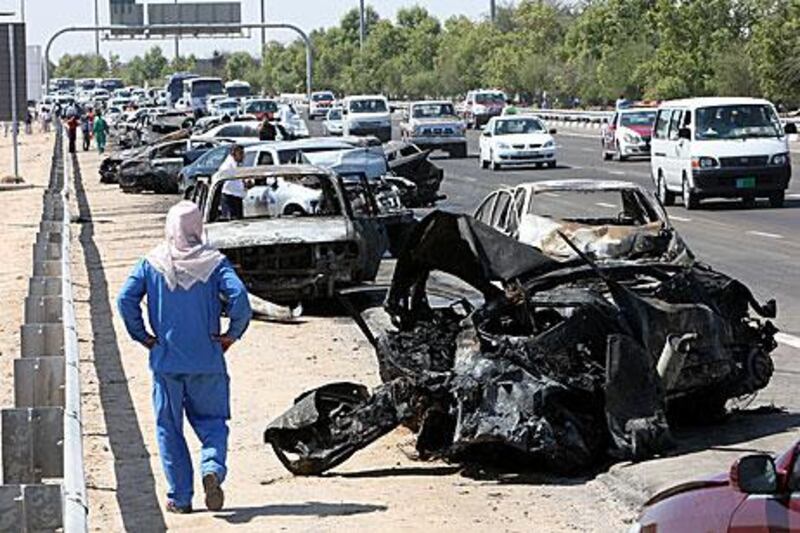ABU DHABI// Many road smashes could have been prevented if drivers had been given real-time traffic and incident information, an expert has claimed.
Warning motorists about road and weather conditions is vital for safety, but paying attention is also essential.
"When you know there are limitations in visibility, the first thing you do is not speed up," said Glenn Havinoviski, an associate vice president of transportation systems at Iteris, a United States company that specialises in traffic management.
"When you're going too fast and don't feel the need to slow down, all you need is one incident to happen and you start a chain reaction."
More than 200 cars crashed during morning rush hour on the E11 near Ghantoot on March 11, 2008, killing four, injuring 350 and leaving 20 cars blazing on what became known as Fog Tuesday.
A year later, another morning commute saw a pile-up of about 30 cars in Jebel Ali, which killed a bus driver and injured 40 others.
In April 2011, a chain of crashes resulted in a death and at least 60 injuries near Al Samha on the Abu Dhabi-Dubai motorway.
"Crashes are generally caused by people going too fast and not paying attention to the road," Mr Havinoviski said.
"There are things that could have been done that would help the drivers be a little bit prepared and one of these is providing real-time information. There was really no mechanism in 2008."
There were no weather sensors installed on roads, no real-time traffic information from a control centre or advance warning road signs, he said.
Traffic management now is about to have travel-time information and pre-trip traveller information systems introduced.
The Department of Transport announced in December 2010 that it would implement an intelligent transportation system (ITS) and operate a transportation management centre to integrate all modes of transport.
"Abu Dhabi has an ambitious ITS programme in place," said Mr Havinoviski, an engineer who has more than 28 years experience in consulting in the US and the Middle East. "They've got the resources and the commitment to do it."
He has worked on the transport department's ITS strategic plan, the development of manuals on traffic control and congestion management, and on a traveller information network.
Supplying drivers with the latest information that could affect their journeys is a key component of the plan. In April, the transport authority said it would fit 80 variable message signs in the city early next year to warn of changing road conditions and give motorists live information in Arabic and English on traffic congestion, building works, roadblocks, crashes and weather conditions.
Fifty-six monitors will send live data on traffic to a central location for real-time analysis. There will be 38 signs notifying drivers of road closures and 48 offering lane-specific information on speed limits, lane closures, road diversions and congestion.
"You'll see more weather sensors and cameras so you can verify the conditions," Mr Havinoviski said. "You'll also see more traffic control devices that detect conditions that reduce travel speeds."
Incident management in Abu Dhabi has improved in recent years, resulting in a smoother flow of traffic and a reduction of injuries, deaths and secondary collisions.
Saaed, a company associated with Abu Dhabi police, responds to and manages minor accidents.
Ibrahim Ramel, chief executive of Saeed, told a road-safety forum last month that they were able to reduce the rate of serious traffic accidents per 100,000 people by 26 per cent, from 127.2 in 2007 to 77 in 2011. The rate of deaths and severe injuries per 100,000 people decreased from 46 in 2007 to 23.1 in 2011.






